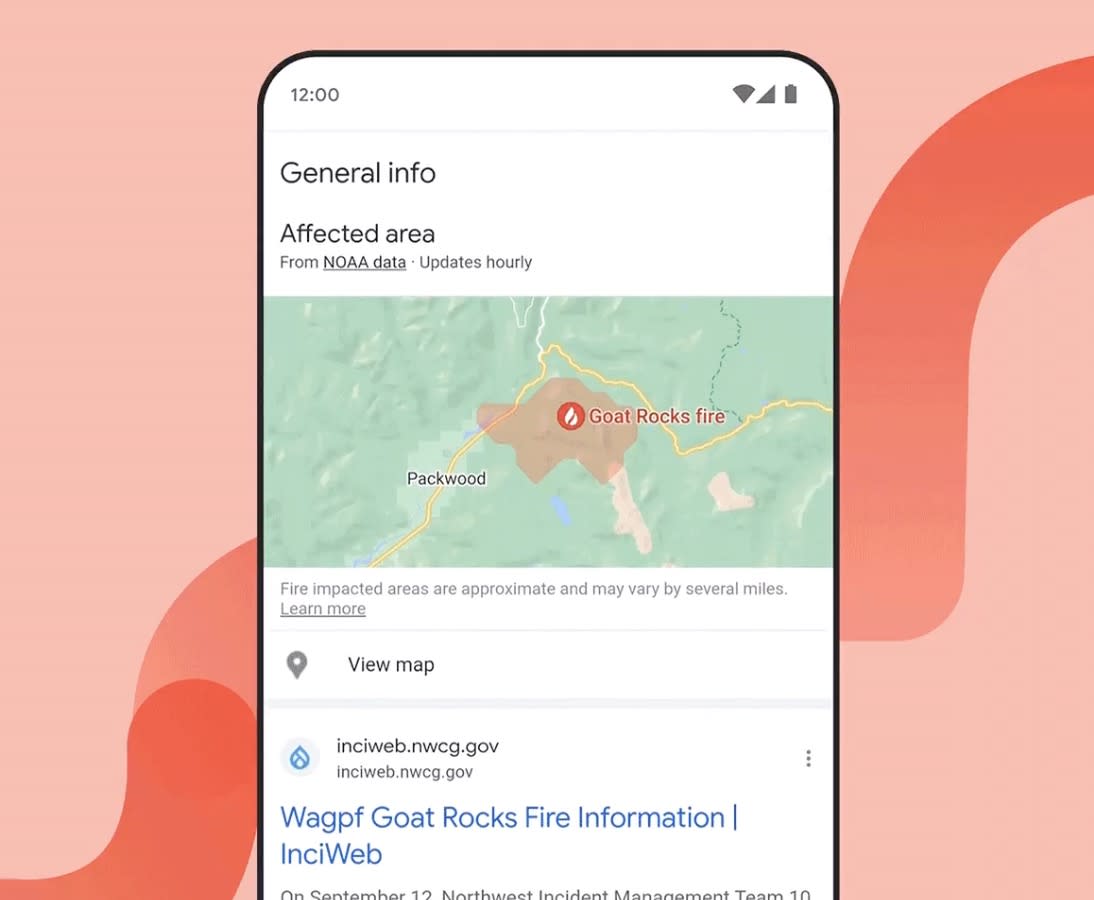Google's wildfire detection is available in US, Mexico, Canada and parts of Australia

- Oops!Something went wrong.Please try again later.
At an AI-focused press event today in New York, Google announced that it's bringing its AI-powered wildfire detection system to the U.S. Canada, Mexico and parts of Australia. It's one of several "AI for good" efforts the company detailed this morning, which also included Google's efforts to expand flood forecasting to more regions around the world.
The previously announced system utilizes machine learning models trained on satellite data to track fires in real time and predict how it will spread. The feature is initially focused on helping first responders determine how best to control the fire.
"Our machine learning models trained using satellite imagery allow us to identify and track wildfires in real time and predict how they will spread, enabling us to support firefighters and other first responders," Katherine Chou, senior director at Google Research, said onstage.
We’ve trained ML models using satellite imagery to identify and track wildfires in real time and predict how they will evolve to support first responders.(https://t.co/RTkFCMGb0k)
We're announcing our wildfire detection system now works in the US, CAN, MX and parts of AUS.(3/5) pic.twitter.com/TX1BnvUjeN
— Google AI (@GoogleAI) November 2, 2022
We’ve trained ML models using satellite imagery to identify and track wildfires in real time and predict how they will evolve to support first responders.(https://t.co/RTkFCMGb0k)
We're announcing our wildfire detection system now works in the US, CAN, MX and parts of AUS.(3/5) pic.twitter.com/TX1BnvUjeN
— Google AI (@GoogleAI) November 2, 2022
This time last year, Google announced that the technology was being added as a layer in Google Maps. The company noted at the time:
[W]e’re now bringing all of Google’s wildfire information together and launching it globally with a new layer on Google Maps. With the wildfire layer, you can get up-to-date details about multiple fires at once, allowing you to make quick, informed decisions during times of emergency. Just tap on a fire to see available links to resources from local governments, such as emergency websites, phone numbers for help and information, and evacuation details. When available, you can also see important details about the fire, such as its containment, how many acres have burned, and when all this information was last reported.
The feature joins a similar ML-based flood forecasting feature announced back in 2018. The former is now being expanded to an additional 18 countries with the global launch of the new FloodHub, Google's platform that displays flood forecasts and shows when and where floods may occur. The countries are: Brazil, Colombia, Sri Lanka, Burkina Faso, Cameroon, Chad, Democratic Republic of Congo, Ivory Coast, Ghana, Guinea, Malawi, Nigeria, Sierra Leone, Angola, South Sudan, Namibia, Liberia and South Africa.
We’ve trained ML models using satellite imagery to identify and track wildfires in real time and predict how they will evolve to support first responders.(https://t.co/RTkFCMGb0k)
We're announcing our wildfire detection system now works in the US, CAN, MX and parts of AUS.(3/5) pic.twitter.com/TX1BnvUjeN
— Google AI (@GoogleAI) November 2, 2022
Google also noted, as previously covered in a piece by Wired, that it's using machine learning models to identify damaged buildings after natural disasters such as hurricanes. By analyzing the same satellite imagery as its wildfire detection tools, the models provide crises responders information about the most heavily hit areas in the first phase of a response effort, Google says.
Google first applied the tech in partnership with nonprofit GiveDirectly to identify and funnel donations to low-income households impacted by Hurricane Ian. More recently, the company applied the models to support government relief efforts during the recent flooding in Pakistan, Chou says.
"We hope to continue to empower organizations to deliver aid faster to those who need it," she added.

